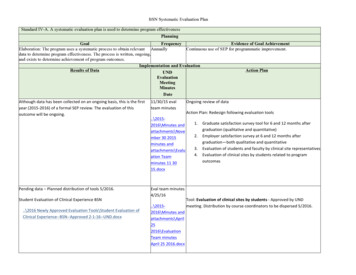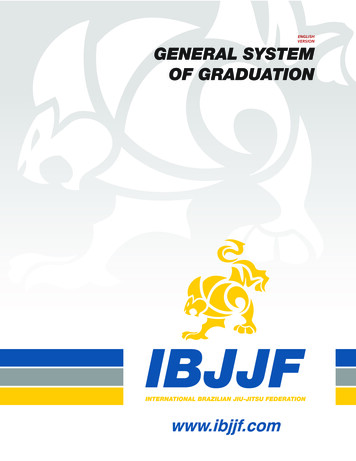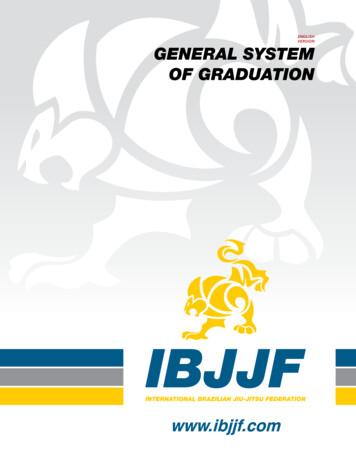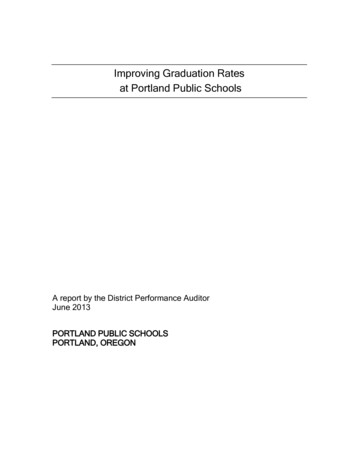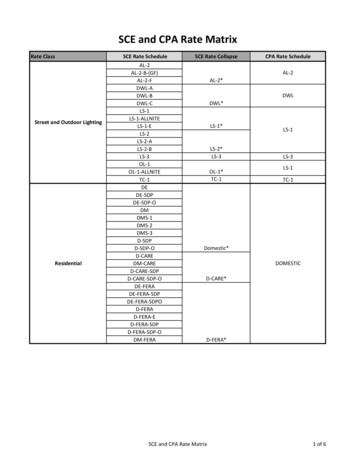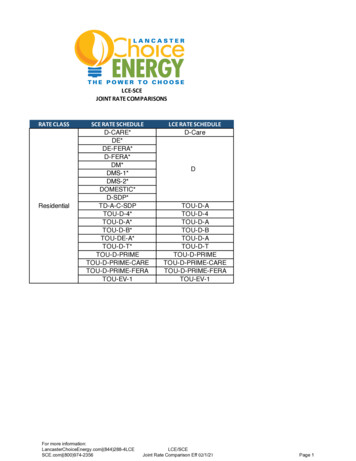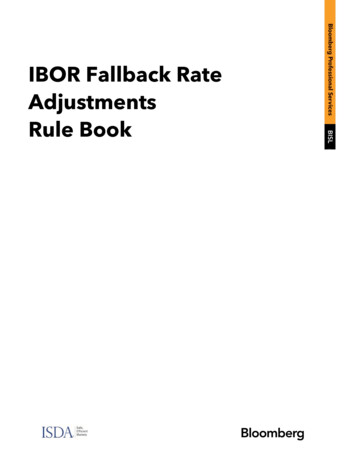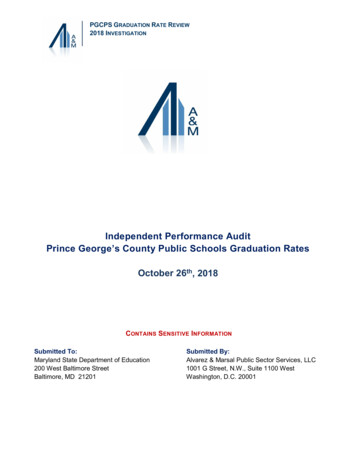
Transcription
PGCPS GRADUATION RATE REVIEW2018 INVESTIGATIONIndependent Performance AuditPrince George’s County Public Schools Graduation RatesOctober 26th, 2018CONTAINS SENSITIVE INFORMATIONSubmitted To:Maryland State Department of Education200 West Baltimore StreetBaltimore, MD 21201Submitted By:Alvarez & Marsal Public Sector Services, LLC1001 G Street, N.W., Suite 1100 WestWashington, D.C. 20001
Table of ContentsI.EXECUTIVE SUMMARY. 3II.INTRODUCTION . 8III.ACTION PLAN ASSESSMENT . 9A.B.C.D.IV.A.B.C.D.E.V.INTRODUCTION .9APPROACH .9GAP ANALYSIS .10IMPLEMENTATION ASSESSMENT .12PERFORMANCE AUDIT . 20INTRODUCTION .20APPROACH BACKGROUND .20RESULTS .31KEY FINDINGS .33ADDITIONAL ANALYSIS AND OBSERVATIONS .38LESSONS LEARNED AND BEST PRACTICES . 49A.B.C.D.E.F.G.H.VI.A.B.C.D.ATTENDANCE .50GRADING .50GRADE CHANGES AND APPEALS.51GRADUATION CERTIFICATION .53CREDIT RECOVERY PROGRAMS .55RECORDS AND CONTROLS.56MONITORING AND COMPLIANCE .57OTHER .59APPENDIX. 61DETAILED ACTION PLAN GAP ANALYSIS .61DETAILED ACTION PLAN IMPLEMENTATION ASSESSMENT .73CONSOLIDATED RECOMMENDATIONS .85SCHOOL SUMMARIES .88Use, duplication, or disclosure is subject to restrictions stated in Contract # R00P8404461 with Alvarez & Marsal.Page 2
I.Executive SummaryAlvarez & Marsal (A&M) was hired by the Maryland State Department of Education (MSDE) to conductan independent performance audit (2018 Audit) of Prince George’s County Public Schools (PGCPS). The2018 Audit which occurred between July 9, 2018 and October 1, 2018, was requested by MSDE as afollow-up from A&M’s previous Audit in 2017 (2017 Audit). In accordance with the Statement of Work(SOW), A&M’s efforts consisted of three phases: An Action Plan Assessment, a follow-up PerformanceAudit, and a consolidation of Best Practices and Lessons Learned from the 2017 and 2018 Audits. Keyfindings and observations from each phase of the 2018 Audit are presented below:Action Plan AssessmentA&M evaluated PGCPS’s efforts to address the 40 unique recommendations from the 2017 Audit,reviewing PGCPS’s Action Plan to identify gaps and assessing the implementation of the Action Plan toidentify any recommendation that were partially implemented or not implemented. The Action Plan Gap Analysis found that PGCPS written Action Plan:o Fully addressed 33 recommendations;o Partially addressed four recommendations;o Did not address three recommendations in their Action Plan. The Implementation Assessment found that PGCPS:o Fully implemented 28 recommendations;o Partially implemented ten recommendations;o And did not implement two recommendations from the 2017 Audit.The table below provides a summary of A&M’s Action Plan Gap Analysis and ImplementationAssessment, highlighting only recommendations which were not fully addressed in the PGCPS ActionPlan or were not fully implemented by PGCPS during SY 17-18. Recommendations that were fullyaddressed and implemented do not appear in the table below.Use, duplication, or disclosure is subject to restrictions stated in Contract # R00P8404461 with Alvarez & Marsal.Page 3
Figure 1: 2017 Audit Remediation GapsCategory &Subcategory2017 Audit Recommendation 1“Configure SchoolMAX to supportmonitoring and enforcement of excessiveabsence procedures for grading or utilizingAttendance:another automated tool to identifySystems /students who have excessive absencesTechnologyand calculate appropriate gradingadjustments in accordance with PGCPSprocedures.”“Implement an independent reviewfunction for grade changes at the schoollevel. ““Perform Representative RandomGradeSampling of grade changes to evaluateChanges &adherence to policies, procedures, andAppeals:timelines, as well as appropriate inclusionMonitoringof documentation requirements. Report/Accountability results to PGCPS administration, internalauditor and school board.”“Report results to PGCPS administration,internal auditor and school board.”GraduationCertification:Overall Policies/ ProceduresGraduationCertification:Monitoring /AccountabilityRecordsAccess andControls:Monitoring /Accountability1RecommendationAddressed inPGCPS ActionPlan?RecommendationImplementedby allyPartially“Require all schools to utilize PDS TallyCards.”“Develop and implement anadministrative procedure which specifiestools and processes required to place astudent on the graduation list and issue adiploma.”“Develop standardized accountabilitypractices that would detect students beingimproperly certified for graduation.”“Establish a program of monitoring,reporting, and following up on excessivegrade changes, or grade changes whichare clearly outside of compliance withprocedures.”These recommendations are quoted directly from A&M’s 2017 Audit report.Use, duplication, or disclosure is subject to restrictions stated in Contract # R00P8404461 with Alvarez & Marsal.Page 4
RecommendationAddressed inPGCPS ActionPlan?RecommendationImplementedby PGCPS?NoNoPartiallyPartially“PGCPS leadership should ensure timelyinvestigation and response intocomplaints to avoid press involvementwith internal complaints.”NoPartially“The Board should receive regularbriefings into any complaints of fraudimpacting student outcomes.”NoPartiallyCategory &SubcategoryGeneralFindings andObservationsonGovernance ofthe District:Monitoring /AccountabilityGeneralFindings andObservationsonGovernance ofthe District:ReportingComplaints ofMisuse orFraud2017 Audit Recommendation 1“To improve school-level accountability,PGCPS leadership should developperformance metrics that can begenerated from SchoolMAX and reviewedquarterly (at a minimum) to monitoradherence to grading procedures. Themetrics will provide leadership insight intotimeliness of grade entry, number ofgrade changes done quarterly, reasons forgrade changes and the impact of thegrade changes.”“Increase accountability via reviewscompleted by an independent third party.Either: 1) expand the auditor role tocomplete performance audits of bothacademic and non-academic areas of theDistrict or 2) create an accountabilityofficer outside of the auditor function toprovide independent oversight ofacademic policies and procedures andstudent performance.”For more details on PGCPS’s actions to address the 2017 Audit recommendations, please see the ActionPlan Assessment section.Performance AuditA&M conducted a comprehensive performance audit, including data analysis, site visits, and recordsreview at each of PGCPS’s 27 high schools.Use, duplication, or disclosure is subject to restrictions stated in Contract # R00P8404461 with Alvarez & Marsal.Page 5
Through a combination of records review, data analysis, interviews, and site visits, A&M identified thefollowing key findings:1. PGCPS greatly reduced the degree to which grade changes were used and misused.2. PGCPS nearly eliminated issues with graduating students who have not met transcript orservice learning requirements.3. PGCPS significantly increased awareness of and compliance with administrative procedure(AP) and state requirements.4. PGCPS did not provide sufficient oversight and support to enforce attendance accountability. PGCPS leadership did not communicate the expectation of compliance with attendancerelated grading requirements and failed to provide tools and processes to ensure adherenceor verify data accuracy.5. Coding errors contributed to inappropriate identification of five of the students in the sampleas eligible to graduate although school certified graduate lists reflected students as nongraduates.A&M selected a sample of 1,085 students from the 7,273 2018 graduates to understand PGCPScompliance with graduation policies and procedures. The performance audit produced the followingresults:Figure 2: 2018 Audit Sample ResultsPGCPS Review Summary2018 PGCPS graduatesStudents included in sampleSample SummaryUnable to determine graduation eligibility due to insufficient grade change documentationIneligible to graduateCount of unique students graduated despite one or more Administrative Procedure violationStudents without grade change or transcript policy In addition to assessing grade changes and transcript eligibility, A&M analyzed PGCPS’s adherence toattendance-related grading requirements. The figure below presents additional analysis thatsummarizes the number of attendance and grading violations according to Administrative Procedure5121.3 in SY 17-18, which requires that students with excessive unlawful absences (5 or more in a .5credit course or 10 or more in a full credit course) be given a failing grade.Figure 3: 2018 Audit Sample Results – Attendance and Grading ViolationsUse, duplication, or disclosure is subject to restrictions stated in Contract # R00P8404461 with Alvarez & Marsal.Page 6
The 60.3% of sample students identified within this group gives further indication that PGCPS did notattempt to adhere to attendance-related grading policies, and that PGCPS Central Office did not supportappropriate tools and analysis needed to support enforcement of this rule. This analysis was directlyimpacted by system errors leading to coding inconsistencies across. Accordingly, A&M madeadjustments to attendance categorization based on PGCPS Student Applications Team guidance.Further information regarding attendance analysis will be presented in the 2018 Graduation Audit.Lessons Learned and Best PracticesAs an outcome of the Action Plan Assessment and Performance Audit, A&M compiled a series of LessonsLearned and Best Practices. The Lessons Learned and Best Practices section is intended to provideguidance for PGCPS and other Maryland School Districts as they address challenges with attendance,grading, and graduation certification.Use, duplication, or disclosure is subject to restrictions stated in Contract # R00P8404461 with Alvarez & Marsal.Page 7
II.IntroductionAlvarez & Marsal was hired by the Maryland State Department of Education to conduct an independentperformance audit of PGCPS. The 2018 Audit was requested by MSDE as a follow-up from the audit ofPGCPS carried out by A&M in 2017. The 2018 Audit occurred between July 9, 2018 and October 1, 2018.In accordance with the Statement of Work (SOW), A&M’s efforts consisted of three phases:(1) An Action Plan Assessment, consisting of an analysis of gaps between PGCPS’s Action Planpublished in December 2017 (Action Plan) and the recommendations included in A&M’s 2017Audit. This analysis was followed by district and school-level interviews to obtain details aboutimplementation efforts surrounding Action Plan items.(2) A follow-up Performance Audit, including visits to 27 schools to collect student cumulativerecords related to grade changes and graduation certification. This effort was supported by dataanalysis of student records in PGCPS’s SchoolMAX student information system (SchoolMAX). TheA&M Team identified a random sample of 1,085 students from an identified 2018 GraduatePopulation of 7,273 students graduates from SY 17-18 across 27 PGCPS High Schools. Inaccordance with the SOW, A&M chose a random sampling methodology to allow extrapolationof the 2018 Graduate Sample results to the larger 2018 Graduate Population from SY 17-18.(3) A consolidation of Best Practices and Lessons Learned from the 2017 Audit and the 2018 Audit,which speak to PGCPS’s successes and challenges addressing problems in the areas of gradechanges, graduation certification, attendance and credit recovery programs.The following report details A&M’s approach to conducting each phase of the 2018 Audit, presentsfindings and recommendations associated with the Action Plan Assessment and Performance Audit, andconcludes with Lessons Learned and Best Practices which can be applied by districts across Maryland.Use, duplication, or disclosure is subject to restrictions stated in Contract # R00P8404461 with Alvarez & Marsal.Page 8
III.A.Action Plan AssessmentIntroductionIn response to A&M’s 2017 Audit findings and recommendations, PGCPS released a detailed Action Planon December 19, 2017 2. Task 1 of the SOW required A&M to assess the degree to which the plannedapproach in the Action Plan addressed the 2017 Audit recommendations and PGCPS’s implementationof each recommendation.B.ApproachA&M compared the Action Plan to each recommendation from the 2017 Audit, evaluating the extent towhich PGCPS fully addressed recommendations in the following focus areas: attendance, grade changesand appeals, grading, credit recovery, graduation certification, records access and controls, and generalfindings and observations on governance of the District. Then, A&M worked to validate theimplementation of these recommendations through onsite interviews and document review—both atthe district-level and the school level. A&M’s Action Plan assessment included the following keyactivities: Review the Action Plan and evaluate the degree to which the plan addresses each of A&M’s2017 findings:o Determine if the public plan and any internal plans were sufficiently documented tofacilitate the successful implementation of the recommended actionso Identify recommendations which the Action Plan failed to addresso Evaluate the degree to which PGCPS’s planned response addresses irregularities foundacross PGCPS High Schools, Central Office departments, and Records facilities Assess PGCPS’s implementation of the Action Plan and related efforts to mitigate issuesidentified in the 2017 Audit and assess effectiveness of improvements, including:o Evaluate changes and improvements to policies, processes, and tools, including: Grading and grade change policies Graduation requirements and certification procedures SchoolMAX Policies, including user access/permissions Recordkeeping policies and procedures Multiple Pathways to Success (MPTS) handbook, policies, and grading. Consider that some action items are to be phased in and may not be fullyimplemented at end of SY 17-18 Assess PGCPS’s efforts to automate processes to reduce risk of error or manipulation, including:o Automation of the Grade Change Authorization Form PS-140 processo Implementation of improved system access controls2PGCPS issued monitoring updates to MSDE from April 2018 through September 2018.Use, duplication, or disclosure is subject to restrictions stated in Contract # R00P8404461 with Alvarez & Marsal.Page 9
Determine the degree to which changes in policies, procedures, and tools have beenappropriately supported with communications and training, including:o Training on updated policies, including the disciplinary steps associated withadministrative procedure violationso Communication to students and families about the updated standards and thesubsequent changes to timelines and/or expectationsAssess PGCPS’s approach to holding schools accountable for proper implementation of policiesand procedures and make recommendations on improving administrative procedure adherence:o Review and assess PGCPS’s monitoring of the 2018 graduating classo Review and assess PGCPS’s oversight regarding implementation of all new/modifiedpolicies and procedures at each high schoolAssess course corrections, including administrative procedure changes, communications andtraining efforts made by PGCPS to determine the efficacy of mid-year changesEvaluate the successful implementation of intended changes across all PGCPS high schoolsAssess updated timelines and associated controls, including changes in grading deadlines, andreport on their impactA&M evaluated PGCPS’s implementation of 2017 Audit recommendations by interviewing 34 districtlevel personnel and requesting follow-up documentation and data to validate their stated progress.A&M also performed interviews of various school personnel at 27 PGCPS high schools which furtherinformed the Action Plan Implementation Assessment.C.Gap AnalysisThe Gap Analysis summarized below assesses PGCPS’s Action Plan responses to the 2017 Auditrecommendations. The totals in Figure 4: Action Plan Gap Analysis Summary represent the number of2017 Audit recommendations that were fully addressed, partially addressed, or not addressed in theAction Plan.Figure 4: Action Plan Gap Analysis SummaryCategoriesAttendanceGrade Changes & AppealsGradingCredit RecoveryGraduation CertificationRecords Access & ControlsGeneral Findings and Observationson Governance of the DistrictTotalRecommendationsFully Addressed566465RecommendationsPartially Addressed020001RecommendationsNot Addressed0000001133343Use, duplication, or disclosure is subject to restrictions stated in Contract # R00P8404461 with Alvarez & Marsal.Page 10
Of the 40 recommendations from the 2017 Audit, 33 were fully addressed in the Action Plan. Fourrecommendations were only partially addressed by the Action Plan, and three recommendations werenot addressed in the Action Plan at all. For a detailed list of all 2017 Audit recommendations andPGCPS’s corresponding Action Plan responses, refer to Appendix A: Detailed Action Plan Gap Analysis.1.Partially AddressedIn the 2017 Audit, A&M recommended that PGCPS “implement an independent review function forgrade changes at the school-level.” PGCPS partially addressed this recommendation, stating that“starting January 2018, PGCPS will produce individual school quarterly grade change reports.” Althoughthis contributes to enhanced awareness of grade change levels, simply producing individual school levelreports provides no specific accountability or monitoring function.A&M also recommended that PGCPS “report [random sampling] results to PGCPS administration,internal auditor and school board.” PGCPS stated that they would “work with the Board of Education todetermine how to best report the information.” This Action Plan statement only partially addressed thisrecommendation because it did not establish how or when random sampling results would be reportedto the specified stakeholders.Additionally, A&M recommended that PGCPS “establish a program of monitoring, reporting, andfollowing up on excessive grade changes, or grade changes outside of compliance with procedures.”PGCPS’s response only partially addressed this recommendation by stating that the “using reports[created by the Division of Information Technology], the Deputy Superintendent will monitor excessivegrade changes and weekly grade inputs.” This response did not provide sufficient detail on the expectedfollow-up from the Deputy Superintendent when irregularities are discovered (e.g., on-siteinvestigations, interviews, and recourse for identified misuse).Furthermore, A&M recommended that PGCPS “Increase accountability via reviews completed by anindependent third party. Either: 1) expand the auditor role to complete performance audits of bothacademic and non-academic areas of the District or 2) create an accountability officer outside of theauditor function to provide independent oversight of academic policies and procedures and studentperformance.” While PGCPS’s Action Plan partially addressed this recommendation, indicating that“PGCPS will hire an independent third party to provide an audit of a random selection of student gradesand graduation requirements at several randomly selected high schools annually.” The Action Plan didnot state that that PGCPS would establish an internal accountability. 3Though not fully-addressed in the Action Plan, PGCPS ultimately has established an accountability function asrecommended.3Use, duplication, or disclosure is subject to restrictions stated in Contract # R00P8404461 with Alvarez & Marsal.Page 11
2.Not AddressedA&M recommended that “to improve school-level accountability, PGCPS leadership should developperformance metrics that can be generated from SchoolMAX and reviewed quarterly (at a minimum) tomonitor adherence to grading procedures. The metrics will provide leadership insight into timeliness ofgrade entry, number of grade changes done quarterly, reasons for grade changes and the impact of thegrade changes.” PGCPS’s Action Plan did not address this recommendation—specifically, their responsedid not establish metrics that would be used and did not state how PGCPS leadership would provideaccountability and leadership once the metrics have been provided.Additionally, PGCPS did not include Action Plan statements to address the two recommendations that“PGCPS leadership should ensure timely investigation and response into complaints to avoid pressinvolvement with internal complaints,” and “the Board should receive regular briefings into anycomplaints of fraud impacting student outcomes.”D.Implementation AssessmentThe following table summarizes A&M’s findings regarding PGCPS’s implementation of the 2017 Auditrecommendations. For additional details, please see Appendix A: Detailed Action Plan Gap Analysis.Figure 5: Implementation Assessment SummaryCategoriesAttendanceGrade Changes and AppealsGradingCredit RecoveryGraduation CertificationRecords Access & Controls 4General Findings andObservations on Governance ofthe endation03003113128102PGCPS FullyImplementedRecommendationPGCPS Did NotImplementRecommendation100000Of the 40 recommendations from the 2017 Audit, 28 were fully implemented; however, tenrecommendations were partially implemented, and two were not implemented at all. Summaries of the4Evaluation and analysis of Records Access and Controls can be found throughout the other sections.Use, duplication, or disclosure is subject to restrictions stated in Contract # R00P8404461 with Alvarez & Marsal.Page 12
“partially implemented” and “not implemented” Action Plan statements can be viewed within the“Implementation Gaps” subheadings within each section below.1.Implementation Assessment by CategoryThe following sections outline key observations and recommendations related to the implementation of2017 Audit recommendations and PGCPS’s Action Plan. The areas for further enhancement providedwithin the following sections below can further improve consistency and accountability related to theissues identified in this investigation.a) AttendanceThe District did not communicate or enforce the attendance-related grading requirements withinadministrative procedures. PGCPS high schools were not expected to assign the letter grade “E” tostudents who had more than five unlawful absences in a semester long course or ten unlawfulabsences in a year-long course.The response from most school staff interviewed was that the attendance-related grading requirementswere not enforced at their school during SY 17-18. Administrators acknowledged that their schools didnot consistently follow the automatic “E” grade for excessive absences, and that individually, they didvery little to enforce this requirement. Nevertheless, most administrators emphasized the many effortsat their schools to get truant students to attend. At one school, an Administrator outlined a process tocompare absences to grades; however, most Administrators did not indicate that they had performedthis type of review.(1)Implementation GapsDespite incorporating A&M’s recommendation to configure SchoolMAX to support monitoring andenforcement of excessive absence procedures for grading into the Action Plan, PGCPS did notimplement this recommendation. PGCPS did not implement new tools to allow monitoring at theschool-level or standardize attendance record keeping and monitoring processes. The Teaching andLearning and Information Technology (IT) departments validated that all schools could run a weeklyschool-level attendance reports. The Action Plan noted that IT would explore the capability ofSchoolMAX to convert excessive unlawful absences to a failing grade. IT did not implement this systemchange.Use, duplication, or disclosure is subject to restrictions stated in Contract # R00P8404461 with Alvarez & Marsal.Page 13
(2)Areas for Further EnhancementA&M recommends that PGCPS: Investigates additional features of SchoolMAX that could support school-level attendanceaccountability. Given the AP 5113 modifications, PGCPS should now consider whether SchoolMAX canautomatically assign a zero for missed assignments when a student is unlawfully absent.Develops a district-level monitoring process including data analysis on the reports from SchoolMAX toensure all schools are following the policies outlined in AP 5113.Provides more substantial training for all administrators on how to implement and monitor adherenceto AP 5113 at their schools.b) Grade Changes and AppealsProcesses and controls for grade changes have significantly improved, and PGCPS has developed anonline grade change form that was piloted and will be used starting in SY 18-19.In visits to individual schools, A&M validated PGCPS’s actions to improve understanding of the gradechange and appeals processes. The clarity on expectations for grade changes has significantly improved,and PGCPS has developed an online grade change form that was piloted and will be used starting in SY18-19. The Student Interventions (SIT) team is now being used for grade appeals to provide a system ofcontrols for grade appeal approvals. Some schools also use the SIT approval process for all gradechanges, though this is not required by Administrative Procedure 5116. Starting in SY 17-18, principalscould download a report that provided a list grade changes that occurred outside of grading window.Additionally, PGCPS has added controls around user roles in SchoolMAX. The principal must submit newaccess requests to authorize a maximum of two employees per role (grade manager and transcriptmanager) unless it is a large school (1500 students), which can authorize three employees. Authorizedemployees are required to attend a mandatory training session with the Technology Training Teambefore they are assigned their role in SchoolMAX. The only exception to the authorization and trainingrequirement is if there is an emergency, at which point the principal can request temporary access for auser.(1)Implementation GapsA&M recommended that PGCPS “implement an independent review function for grade changes at theschool-level,” and “perform Representative Random Sampling of grade changes to evaluate adherenceto policies, procedures, and timelines, as well as appropriate inclusion of documentation requirements.”PGCPS partially implemented these two reco
analysis of student records in PGCPS's SchoolMAX student information system (SchoolMAX). The A&M Team identified a random sample of 1,085 students from an identified 2018 Graduate Population of 7,273 students graduates from SY 17-18 across 27 PGCPS High Schools. In
